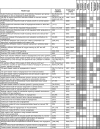A systems biology view of blood vessel growth and remodelling
- PMID: 24237862
- PMCID: PMC4190897
- DOI: 10.1111/jcmm.12164
A systems biology view of blood vessel growth and remodelling
Abstract
Blood travels throughout the body in an extensive network of vessels - arteries, veins and capillaries. This vascular network is not static, but instead dynamically remodels in response to stimuli from cells in the nearby tissue. In particular, the smallest vessels - arterioles, venules and capillaries - can be extended, expanded or pruned, in response to exercise, ischaemic events, pharmacological interventions, or other physiological and pathophysiological events. In this review, we describe the multi-step morphogenic process of angiogenesis - the sprouting of new blood vessels - and the stability of vascular networks in vivo. In particular, we review the known interactions between endothelial cells and the various blood cells and plasma components they convey. We describe progress that has been made in applying computational modelling, quantitative biology and high-throughput experimentation to the angiogenesis process.
Keywords: angiogenesis; computational model; mathematical model; multi-scale modelling; systems biology.
© 2013 The Authors. Journal of Cellular and Molecular Medicine published by John Wiley & Sons Ltd and Foundation for Cellular and Molecular Medicine.
Figures



Similar articles
-
A review of mathematical models for the formation of vascular networks.J Theor Biol. 2013 Sep 21;333:174-209. doi: 10.1016/j.jtbi.2013.04.037. Epub 2013 May 16. J Theor Biol. 2013. PMID: 23684907 Review.
-
Modelling of endothelial cell migration and angiogenesis in microfluidic cell culture systems.Biomech Model Mechanobiol. 2019 Jun;18(3):717-731. doi: 10.1007/s10237-018-01111-3. Epub 2019 Jan 2. Biomech Model Mechanobiol. 2019. PMID: 30604299
-
Mathematical modelling of angiogenesis.J Neurooncol. 2000 Oct-Nov;50(1-2):37-51. doi: 10.1023/a:1006446020377. J Neurooncol. 2000. PMID: 11245280 Review.
-
Blood vessel remodeling in pig ovarian follicles during the periovulatory period: an immunohistochemistry and SEM-corrosion casting study.Reprod Biol Endocrinol. 2009 Jul 16;7:72. doi: 10.1186/1477-7827-7-72. Reprod Biol Endocrinol. 2009. PMID: 19607713 Free PMC article.
-
Mathematical modelling of flow through vascular networks: implications for tumour-induced angiogenesis and chemotherapy strategies.Bull Math Biol. 2002 Jul;64(4):673-702. doi: 10.1006/bulm.2002.0293. Bull Math Biol. 2002. PMID: 12216417
Cited by
-
Tenascin-C: Exploitation and collateral damage in cancer management.Cell Adh Migr. 2015;9(1-2):141-53. doi: 10.1080/19336918.2014.1000074. Cell Adh Migr. 2015. PMID: 25569113 Free PMC article. Review.
-
A Comparative Study of HA/DBM Compounds Derived from Bovine and Porcine for Bone Regeneration.J Funct Biomater. 2023 Aug 24;14(9):439. doi: 10.3390/jfb14090439. J Funct Biomater. 2023. PMID: 37754853 Free PMC article.
-
Biofabrication of thick vascularized neo-pedicle flaps for reconstructive surgery.Transl Res. 2019 Sep;211:84-122. doi: 10.1016/j.trsl.2019.05.003. Epub 2019 May 21. Transl Res. 2019. PMID: 31170376 Free PMC article. Review.
-
Vascularized Microfluidics and the Blood-Endothelium Interface.Micromachines (Basel). 2019 Dec 23;11(1):18. doi: 10.3390/mi11010018. Micromachines (Basel). 2019. PMID: 31878018 Free PMC article. Review.
-
Improvement of diabetic wound healing by topical application of Vicenin-2 hydrocolloid film on Sprague Dawley rats.BMC Complement Altern Med. 2019 Jan 17;19(1):20. doi: 10.1186/s12906-018-2427-y. BMC Complement Altern Med. 2019. PMID: 30654793 Free PMC article.
References
-
- Carmeliet P. Angiogenesis in life, disease and medicine. Nature. 2005;438:932–6. - PubMed
-
- Sung H-K, Michael IP, Nagy A. Multifaceted role of vascular endothelial growth factor signaling in adult tissue physiology: an emerging concept with clinical implications. Curr Opin Hematol. 2010;17:206–12. - PubMed
-
- Egginton S. Invited review: activity-induced angiogenesis. Pflugers Arch. 2009;457:963–77. - PubMed
-
- Carmeliet P. Angiogenesis in health and disease. Nat Med. 2003;9:653–60. - PubMed
-
- Bentley K, Jones M, Cruys B. Predicting the future: towards symbiotic computational and experimental angiogenesis research. Exp Cell Res. 2013;319:1240–6. - PubMed
Publication types
MeSH terms
Grants and funding
LinkOut - more resources
Full Text Sources
Other Literature Sources

